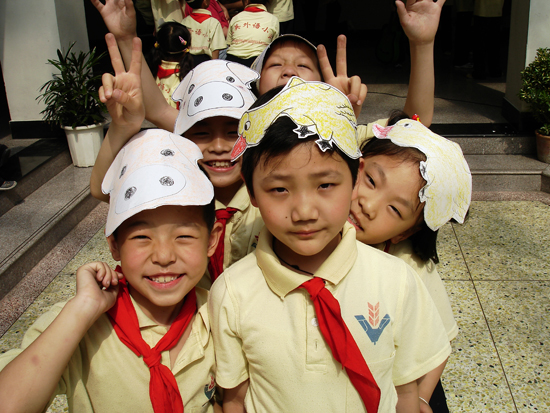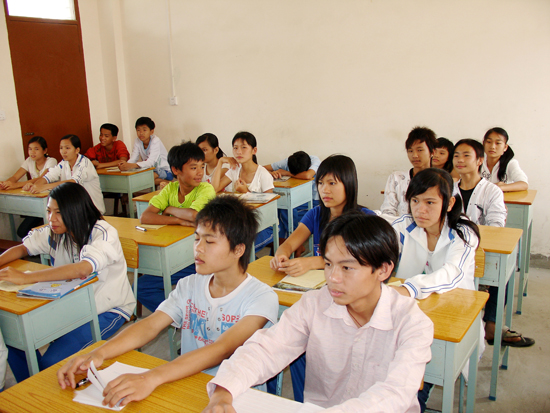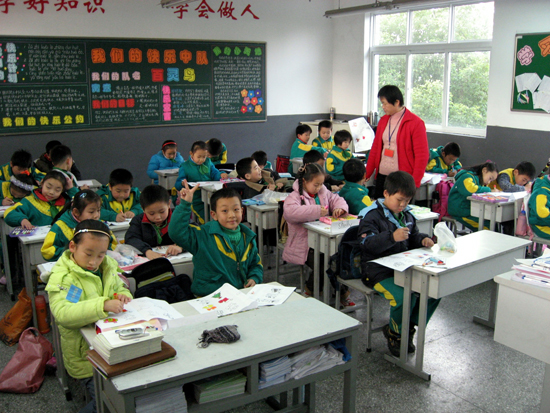Education: Education Structure
Introduction
School is compulsory for Chinese children between the ages of six and 15 years. Homeschooling is illegal across the country. Mandarin is used as the medium of instruction in most schools. In elementary and secondary schools for ethnic minorities, minority languages such as Mongolian, Tibetan, and Korean, are also used. Almost all secondary schools as well as some elementary schools require students to wear uniforms. These usually consist of two sets, one for summer and one for winter. Uniforms in the winter usually consist of a zip-up sweatshirt worn over a shirt or blouse. The summer uniform is a collared shirt and pants, with girls also having the option of wearing a skirt.
Formal structure of the school system
Primary
Type of school providing this education: Primary school
Length of program: 6 years
Age: 6 to 12 years
Lower Secondary
Type of school providing this education: Ordinary junior middle school
Length of program: 3 years
Age: 12 to 15 years
Vocational Secondary
Type of school providing this education: Vocational junior middle school
Length of program: 3 years
Age: 12 to 15 years
Higher Secondary
Type of school providing this education: Ordinary senior middle school
Length of program: 3 years
Age: 15 to 18 years
Certificate/diploma awarded: Senior High School Graduation Diploma
Technical
Type of school providing this education: technical secondary school/technical school/vocational senior high school
Length of program: 3 years
Age: 15 to 18 years
Certificate/diploma awarded: Graduation Diploma
Compulsory education lasts for nine years, starting at six or seven years of age, and starts with six years primary education. Secondary education extends over six years, divided into junior (compulsory) and senior secondary (non-compulsory) education.
A graduation examination is taken at the end of secondary schooling to acquire the Senior High School Graduation Diploma. Access to higher education is based on the award of this diploma and a very competitive written examination, termed the Gaokao.
School Timetable
Chinese schools operate a two-semester school year as indicated below; however, rural schools generally operate on a more flexible schedule geared to the needs of the agricultural seasons. To promote attendance and allow completion of the class schedule and academic year, agricultural seasons are taken into account. School holidays can be moved and school days shortened, with additional classes then offered in the slack agricultural seasons.
Semester dates: (One) Early September to January, (Two) Early March to July
School days: Monday to Friday, Saturday attendance required leading up to final leaving examination
School hours: 07:10 to 15:30*
* Based on an urban school in Beijing. Regional variation is common.
Grading System
Most secondary schools in China use a grading scale of A to D for The Senior High School Graduation Diploma. Each subject of The National Matriculation Test is marked on a percentage scale, with a maximum total grade of 750. At higher education institutions, a percentage scale is normally used, with the lowest passing grade at 60 percent. Some schools/programs use a pass/fail scale or A to F scale.
Cost of Schooling
The compulsory schooling program is free for all Chinese citizens. Parents pay a small fee per term for books and other expenses, such as transportation, food, and heating. This can be waived for families in economic difficulty.
For non-compulsory education, China operates a shared-cost mechanism, where tuition fees are charged at certain percentage of the cost. The Chinese government has initiated scholarships, work-study programs, and subsidies for students with economic difficulties. These assistance programs ensure that pupils from low-income families can attend senior secondary schools and have access to higher education.
The government operates a development fund to continuously improve conditions in China's elementary and high schools. Schools receive central funds for new construction, expansion, and the rebuilding of run-down structures. Since the mid-1980s, educational expenditure per elementary and high school student has grown tremendously, with yearly updates to teaching and research supplies.
Despite this investment, the government recognizes that certain areas of the country can be defined as ‘economically backward.' These are mainly rural areas away from the seaboard and large urban centers of the country. It is estimated that 25 percent of China’s school population resides in these areas, where schools require more resources than can be currently provided if China is to meet its aim of providing a modern schooling system of international standard countrywide.
Special Schools
For many years, Chinese children with severe learning problems and those with physical disabilities and psychological problems were the responsibilities of their families. This situation changed during educational reform in 1985, which introduced special education for both gifted children and for learners with special needs. The strategy has been to provide extra instruction for both categories of students within the regular school system; currently about two-thirds of China's disabled students remain in regular state schools. Where special schooling is required, China has over 1,500 schools and 1,000 vocational training centers providing such specialized teaching.
In areas of China with large populations of ethnic minorities, schools are often referred to as "ethnic minority schools." These schools operate exactly as regular state schools and follow the national curriculum, but teaching is provided in the relevant minority language. Increasingly these schools are becoming bilingual, with the promotion of Mandarin as a medium of instruction in all areas.
China has banned formal religious education, except in licensed schools of theology, which are usually at the college level and above. These colleges receive state support, but are usually very small with limited enrollments and budgets. Religious education for school-aged children is usually given in private homes. Religious teachers move around the country on a weekly or monthly circuit, staying as guests in private houses in exchange for teaching.
Curriculum
The Ministry of Education sets and refines a national curriculum, which is implemented in schools across China. At the primary school level, this consists of Chinese, mathematics, physical education, music, drawing, and elementary instruction in nature, history, and geography, combined with practical work experiences around the school compound. Schools are also instructed to ensure pupils develop a general knowledge of politics as part of the curriculum. A foreign language, often English, is introduced usually around the third year of study. Chinese and mathematics account for about 60 percent of the scheduled class time, and these two subjects also form a significant part of the secondary curriculum.
The Ministry of Education requires that all primary schools offer courses on morality and ethics. As part of these courses, students typically have to perform productive labor for two weeks per semester. This enforces the relationship of academic study to production experience in workshops or on farms.
The secondary curriculum builds on the subjects learned at primary school, but in addition to normal lessons, periods for private study and extracurricular activity are provided. The academic curriculum introduces new subjects at this level, such as physics and chemistry, as well as fine arts and practical aspects of computing. Chinese, mathematics, and English are considered the three main subjects and are also the main subjects assessed in the Gaokao examination.
Ministry of Education of the People's Republic of China
No.37 Damucang Hutong
Xidan
Beijing 100816
People's Republic of China
Tel: [86] 10 6609 6114
Web: www.moe.edu.cn
Copyright © 1993—2025 World Trade Press. All rights reserved.

 China
China 

